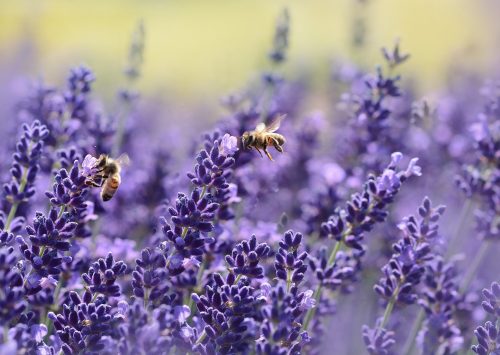“According to all known laws of aviation, there is no way that a bee should be able to fly.” This opening line from the Bee Movie echoes a fascination people have with the abilities of bees. Although the line may exaggerate their physics-defying flight capabilities, bees are nonetheless impressive creatures. Despite their tiny brains, bees possess complex cognitive skills—including mathematical capabilities.
Scarlett Howard, a postdoctoral fellow at the Research Center on Animal Cognition at Paul Sabatier University in France, has been studying bee cognition for years, recently showing that honeybees can learn addition and subtraction on top of other previously known mathematical abilities.
Sensing ratios or abstract reasoning?
Many studies have demonstrated that a variety of animals have basic numerical skills, such as counting or understanding ratios. However, there is an important distinction between measuring absolute quantities and representing numbers abstractly. This abstract representation is more difficult but key to more advanced mathematical abilities, enabling us to count and order numbers as well as perform actions such as addition and subtraction. So far, the ability to add or subtract has been found in certain primates, pigeons, African grey parrots, and spiders. Earlier honeybee studies have concluded that they have some advanced cognitive skills, and thus might also understand mathematical concepts.
As seen in previous research, honeybees can learn distinctions such as left and right, above and below, same and different, and larger and smaller. When trained using food rewards, they can also count and differentiate numbers. In fact, honeybees can also understand “greater than” or “less than,” as well as the concept of zero. Professor Howard’s newest study of honeybees tests more complex numerical reasoning: addition and subtraction, which require the use of two separate cognitive systems. Animals use long-term memory to recall the rules of addition and subtraction but short-term memory to do math with the specific numbers.
To test whether honeybees understand addition and subtraction, Howard used a food-based reward and punishment procedure. Subjects were recruited from free flying honeybees at the nearby sucrose feeder. To motivate the honeybees during training, researchers placed a tasty sucrose solution on the correct answer and a foul-tasting quinine solution on the incorrect answer.
How to train a honeybee
One benefit of using honeybees as the model organism is that they have incredible endurance during experiments. In most animal research, keeping the subjects engaged rather than tired or bored is a huge challenge. Honeybees rarely have this issue; they will search for food as long as the sun is up. “We’re just taking advantage of their natural foraging strategy, which is to work all day and collect nutrition for the hive,” Howard said. The lab was able to get individual bees to participate in their experiments for up to seven hours.
Honeybees also have good color vision, so the researchers used different sized yellow and blue squares as the number stimuli. During the training phase, researchers taught the honeybees to recognize the colors yellow and blue to represent “subtraction by one” and “addition by one,” respectively. During training and testing, the honeybees entered the first room in a Y-shaped maze and saw a group of between one to five colored squares, representing the first number. Next, bees flew into a “decision chamber” and chose either the correct or incorrect number of squares, based on whether the color stimulus asked for addition or subtraction. If the stimulus was blue, bees needed to subtract by one, and if the stimulus was yellow, they needed to add by one.
Testing the honeybees
Researchers ran bees through four tests, two for addition and two for subtraction. In addition, conditions varied the direction of wrong answers. Ensuring that the bees can learn the right answers even with different numerical directions showed that their choices represent a flexible and robust understanding of math adaptable to various circumstances.
The final results showed that the honeybees performed significantly better than chance. Over the course of one hundred reinforced trials in which right answers held tasty food, honeybees learned to choose the correct answers, improving as trials continued. The honeybees’ performance demonstrated that over many reinforced trials, they can learn to use color as a representation for when to add or subtract. The experimental design required bees to use both long and short-term memory to learn addition and subtraction because they could not see the original stimulus when choosing. Thus, the honeybees’ behavior illustrated that they can develop a robust mathematical understanding beyond mere ratio sensitivity found in other species.
What are the implications?
Investigating how honeybees’ small brains quickly learn complex rules may help improve AI learning and processing systems, especially simple neural networks. “We’re seeing a few artificial neural networks which are quite simple, but are’t able to do the tasks that we’ve shown the honeybees can do,” Howard said. But to improve AI learning, researchers need a better understanding of how honeybees’ brains actually work. Moving forward, Howard wants to focus his research on how honeybees actually process numbers within their brains. “We know about what happens in primates and birds, but we don’t know anything about what happens when insects are processing numbers,” he said.
Complex math and reasoning skills are often cited as an example of what sets humans apart from other animals. Finding that honeybees can add and subtract suggests that numerical cognition is more widespread than previously thought and that other insects might be able to learn advanced math skills too. Honeybees’ performance also shows that a large brain is not required for complex numerical cognition. “Bees are quite smart,” Howard said. “They surprise us every time we give them a task and they show us that they can do it.”

